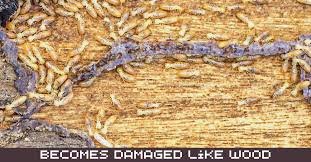Wood, a versatile and widely used material, is cherished for its natural beauty and strength. However, wood is also prone to damage and deterioration over time. In this article, we will explore the various ways wood can become damaged Like Wood, the factors contributing to its decay, and methods to prevent and address these issues. By understanding the processes that lead to wood damage, we can better preserve and maintain wooden structures and objects.
The Nature of Wood and Its Vulnerability
The Composition of Wood
Wood is composed of cellulose fibers bound together by lignin, which gives it strength and rigidity. The natural structure of wood makes it a durable material, but also one that is susceptible to various forms of damage.
Factors Contributing to Wood Damage
Several factors contribute to the deterioration of wood, including environmental conditions, biological organisms, and physical forces. Understanding these factors is crucial to mitigating damage and extending the life of wooden materials.
Types of Wood Damage
Physical Damage
Mechanical Stress
Wood can suffer from mechanical stress due to load-bearing or impact forces. Over time, these stresses can lead to cracks, splits, and other forms of structural damage.
Abrasion and Wear
Continuous use and exposure to abrasive materials can wear down the surface of wood, leading to a loss of finish and surface integrity.
Environmental Damage
Moisture and Humidity
Moisture is one of the primary culprits in wood damage. Wood absorbs and releases moisture from the environment, leading to swelling, shrinking, and warping. Prolonged exposure to high humidity or water can cause rot and decay.
Temperature Fluctuations
Wood expands and contracts with temperature changes. Repeated cycles of heating and cooling can lead to stress fractures and a loss of structural integrity.
Biological Damage
Fungal Decay
Fungi thrive in moist environments and can cause significant damage to wood. Wood becomes damaged like wood infected with fungi, resulting in rot and decay.
Insect Infestation
Insects such as termites, beetles, and ants can burrow into wood, creating tunnels and weakening its structure. This type of damage is often hidden until it becomes severe.
Identifying Wood Damage
Visual Inspection
Regular visual inspections can help identify signs of wood damage early. Look for cracks, discoloration, warping, and evidence of insect activity.
Sound Test
Tapping on wood can reveal hollow or soft areas, indicating internal damage or decay.
Moisture Meters
Using a moisture meter can help detect excessive moisture levels in wood, which can lead to rot and fungal growth.
Preventing Wood Damage
Proper Sealing and Finishing
Sealing wood with appropriate finishes can protect it from moisture and environmental damage. Regular maintenance of these finishes is essential to ensure continued protection.
Controlling Environmental Conditions
Maintaining stable humidity and temperature levels can reduce the risk of wood damage. Using dehumidifiers and proper ventilation can help control moisture levels.
Treating Wood
Treating wood with preservatives and insecticides can protect it from biological damage. These treatments penetrate the wood and provide long-term protection against fungi and insects.
Repairing Damaged Wood
Surface Repairs
For minor surface damage, sanding and refinishing can restore the appearance and integrity of the wood. Filling cracks and holes with wood filler can also be effective.
Structural Repairs
Severe structural damage may require more extensive repairs, such as replacing Becomes Damaged Like Wood sections or reinforcing weakened areas with additional support.
Professional Restoration
In cases of significant damage, professional restoration services can provide expertise in repairing and restoring wood to its original condition.
Case Studies of Wood Damage and Restoration
Historic Building Preservation
Historic buildings often feature significant wooden elements that require careful preservation. Case studies of successful restorations provide valuable insights into techniques and best practices for maintaining these structures.
Furniture Restoration
Antique furniture is particularly susceptible to wood damage due to age and use. Examining restoration projects can offer guidance on preserving the beauty and functionality of wooden furniture.
FAQs on Wood Damage and Preservation
1. What are the most common causes of wood damage?
Answer: The most common causes of wood damage include:
Moisture and Humidity: Excessive moisture leads to swelling, warping, and rot.
Fungal Decay: Fungi thrive in moist environments and can cause significant rot.
Insect Infestation: Termites, beetles, and ants can burrow into wood, weakening its structure.
Mechanical Stress: Load-bearing or impact forces can cause cracks and splits.
Temperature Fluctuations: Repeated cycles of heating and cooling can cause stress fractures.
2. How can I prevent my wooden furniture from becoming damaged?
Answer: To prevent wood damage:
Proper Sealing and Finishing: Apply protective finishes to seal the wood from moisture.
Control Environmental Conditions: Maintain stable humidity and temperature levels using dehumidifiers and proper ventilation.
Regular Maintenance: Inspect and maintain finishes, and repair any minor damage promptly.
Treat Wood: Use preservatives and insecticides to protect against biological damage.
3. What are the signs that wood has become damaged?
Answer: Signs of wood damage include:
Visual Indicators: Cracks, discoloration, warping, and evidence of insect activity.
Sound Test: Hollow or soft sounds when tapping on the wood, indicating internal damage.
Moisture Levels: Excessive moisture detected by moisture meters can indicate potential for rot and fungal growth.
4. How can I repair minor damage to wood surfaces?
Answer: For minor surface damage:
Sanding: Smooth the Becomes Damaged Like Wood area with sandpaper.
Refinishing: Apply a new finish to restore appearance and protection.
Filling Cracks and Holes: Use wood filler to repair small cracks and holes.
Regular Maintenance: Keep up with regular maintenance to prevent further damage.
5. When should I seek professional help for wood damage?
Answer: Seek professional help when:
Structural Damage: If the wood has significant structural damage or extensive decay.
Historic Preservation: For the restoration of historic or antique wooden items.
Complex Repairs: When the damage requires specialized tools or expertise that you do not possess.
Insect Infestation: If there is a severe infestation that requires professional pest control services.
Conclusion
Wood is a beautiful and functional material, but it is not immune to damage. By understanding the various ways wood can becomes damaged Like Wood and taking proactive steps to prevent and address these issues, we can ensure that wooden structures and objects continue to be enjoyed for generations. Whether through regular maintenance, environmental control, or professional restoration, preserving wood requires a comprehensive approach to combat the factors that lead to its deterioration.





